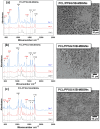Boron-Doped Mesoporous Bioactive Glass Nanoparticles (B-MBGNs) in Poly(ε-caprolactone)/Poly(propylene succinate- co-glycerol succinate) Nanofiber Mats for Tissue Engineering
- PMID: 40511785
- PMCID: PMC12284861
- DOI: 10.1021/acsabm.4c01871
Boron-Doped Mesoporous Bioactive Glass Nanoparticles (B-MBGNs) in Poly(ε-caprolactone)/Poly(propylene succinate- co-glycerol succinate) Nanofiber Mats for Tissue Engineering
Abstract
Increased demand for advanced biomaterials in tissue engineering has driven research to develop innovative solutions based on smart material combinations. Mesoporous bioactive glass nanoparticles (MBGNs) have emerged as attractive materials because of their angiogenic and regenerative properties. This study explores the incorporation of boron-doped mesoporous bioactive glass nanoparticles (B-MBGNs) into poly(ε-caprolactone) (PCL) and poly(propylene succinate-co-glycerol succinate) (PPSG) fibers to enhance their biodegradation and bioactivity. B-MBGNs were synthesized via a microemulsion-assisted sol-gel method and characterized through morphology, pore size distribution, composition, and surface area. PCL/PPSG nanofibers were fabricated using an alternative combination of solvents, formic acid, and acetic acid. B-MBGNs were incorporated into PCL/PPSG solutions at concentrations of 5, 10, and 15 wt % and electrospun into nanofiber mats under a flow rate of 0.2 mL/h at 22 °C and 40% relative humidity, while the voltage applied at the needle tip was 18 kV and -2 kV at the rotating drum. The addition of 10 wt % of B-MBGNs resulted in nanofibers that exhibited a high degradation rate in PBS with a weight loss of 44% in 30 days, significant hydrophilicity with a contact angle of 33°, and improvements in cell viability tested with normal human dermal fibroblasts (NHDF). In addition, the study highlights the effect of the concentration of B-MBGNs on the morphology of the fibers, which can agglomerate and form undesired beads. Although the particles improved cellular activity, the changes in morphology caused tension points that reduced the elasticity of the fibers. Overall, this work contributes to the innovative use of green polyesters combined with boron ions in electrospun fibrous scaffolds, expanding the opportunities for applications in tissue regeneration, for example, to treat chronic wounds in diabetic patients.
Keywords: benign solvents; biodegradable polymers; electrospinning; mesoporous bioactive glass nanoparticles; scaffolds.
Figures








Similar articles
-
Incorporation of Poly(propylene succinate-co-glycerol succinate) (PPSG) as a Renewable Additive in Electrospun PCL Fibers with Bioactive Glass Particles for Soft Tissue Engineering.ACS Appl Bio Mater. 2025 Jun 16;8(6):4791-4804. doi: 10.1021/acsabm.5c00176. Epub 2025 Jun 3. ACS Appl Bio Mater. 2025. PMID: 40459555 Free PMC article.
-
Chitosan/Bioactive Glass Microparticles Enriched with Therapeutic Metal Ions for Bone Tissue Engineering.ACS Appl Bio Mater. 2025 Aug 18;8(8):7201-7215. doi: 10.1021/acsabm.5c00930. Epub 2025 Jul 28. ACS Appl Bio Mater. 2025. PMID: 40726068 Free PMC article.
-
Electrospun poly(ε-caprolactone)/poly(glycerol sebacate) aligned fibers fabricated with benign solvents for tendon tissue engineering.J Biomed Mater Res A. 2025 Jan;113(1):e37794. doi: 10.1002/jbm.a.37794. Epub 2024 Sep 18. J Biomed Mater Res A. 2025. PMID: 39295227
-
Modeling the structural and functional properties of bioactive glasses: Atomic to macro-scale perspectives.Acta Biomater. 2025 Aug;202:45-65. doi: 10.1016/j.actbio.2025.06.048. Epub 2025 Jun 25. Acta Biomater. 2025. PMID: 40578775 Review.
-
Innovations in Core-Shell Electrospinning: A Comprehensive Review in Recent Advances of Core-Shell Electrospun Polylactic Acid Nanocomposite Fibers for Potential Biomedical Applications.ACS Biomater Sci Eng. 2025 Jul 14;11(7):3826-3857. doi: 10.1021/acsbiomaterials.5c00194. Epub 2025 Jun 16. ACS Biomater Sci Eng. 2025. PMID: 40522934 Review.
References
-
- Chen X., Zhao Y., Geng S., Miron R. J., Zhang Q., Wu C., Zhang Y.. In Vivo Experimental Study on Bone Regeneration in Critical Bone Defects Using PIB Nanogels/Boron-Containing Mesoporous Bioactive Glass Composite Scaffold. Int. J. Nanomed. 2015;10:839–846. doi: 10.2147/IJN.S69001. - DOI - PMC - PubMed
-
- Balasubramanian P., Büttner T., Miguez Pacheco V., Boccaccini A. R.. Boron-Containing Bioactive Glasses in Bone and Soft Tissue Engineering. J. Eur. Ceram. Soc. 2018;38(3):855–869. doi: 10.1016/j.jeurceramsoc.2017.11.001. - DOI
-
- Wu C., Miron R., Sculean A., Kaskel S., Doert T., Schulze R., Zhang Y.. Proliferation, Differentiation and Gene Expression of Osteoblasts in Boron-Containing Associated with Dexamethasone Deliver from Mesoporous Bioactive Glass Scaffolds. Biomaterials. 2011;32(29):7068–7078. doi: 10.1016/j.biomaterials.2011.06.009. - DOI - PubMed
MeSH terms
Substances
LinkOut - more resources
Full Text Sources
